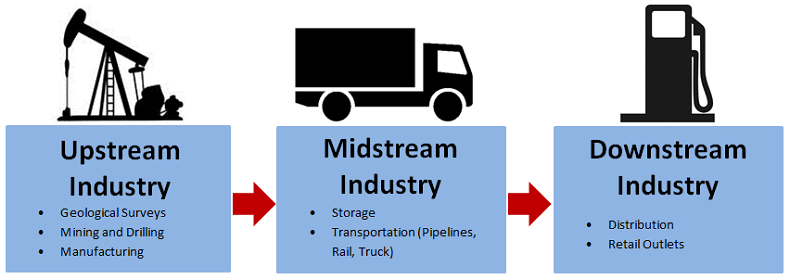Downstream oil and gas industry: Difference between revisions
J.williams (talk | contribs) m 1 revision imported |
m 1 revision imported |
||
| (3 intermediate revisions by 2 users not shown) | |||
| Line 1: | Line 1: | ||
[[Category:Done | [[Category:Done 2018-08-03]] | ||
<onlyinclude>'''Downstream industry''' is the portion of the [[oil]] and [[natural gas]] industry that is responsible for the refining, distributing, and retail of [[petroleum]] products. This portion of industry includes [[oil refinery|oil refineries]], [[petrochemical]] plants, petroleum products distributors, and natural gas distribution companies.</onlyinclude> Downstream industry provides numerous products such as jet fuel, [[gasoline]], [[diesel]], synthetic rubber, plastics, pesticides, pharmaceuticals, natural gas, and [[propane]].<ref>PSAC. (June 11, 2015). ''Industry Overview'' [Online]. Available: http://www.psac.ca/business/industry-overview/</ref> | <onlyinclude>'''Downstream industry''' is the portion of the [[oil]] and [[natural gas]] industry that is responsible for the refining, distributing, and retail of [[petroleum]] products. This portion of industry includes [[oil refinery|oil refineries]], [[petrochemical]] plants, petroleum products distributors, and natural gas distribution companies.</onlyinclude> Downstream industry provides numerous products such as jet fuel, [[gasoline]], [[diesel]], synthetic rubber, plastics, pesticides, pharmaceuticals, natural gas, and [[propane]].<ref>PSAC. (June 11, 2015). ''Industry Overview'' [Online]. Available: http://www.psac.ca/business/industry-overview/</ref> | ||
| Line 10: | Line 10: | ||
==Environmental Impacts== | ==Environmental Impacts== | ||
There are several environmental impacts that can be connected to various downstream petroleum activities. Distribution activities can be heavily reliant on [[fossil fuel]]s, which can result in more [[greenhouse gas]] [[emission]]s to the [[atmosphere]]. | There are several environmental impacts that can be connected to various downstream petroleum activities. Distribution activities can be heavily reliant on [[fossil fuel]]s, which can result in more [[greenhouse gas]] [[emission]]s to the [[atmosphere]]. These emissions include [[carbon dioxide]], [[sulfur]] oxides ([[SOx]]) and [[nitrogen]] oxides ([[NOx]]); along with occasional releases of hazardous materials such as solvents or groundwater contamination from production.<ref>E. La Rovere, J. Mariano. (June 12, 2015). ''Environmental Impacts of the Oil Industry'' [Online]. Available: http://www.eolss.net/sample-chapters/c08/e6-185-18.pdf</ref> 2013 estimates report that the downstream oil and gas sector contributed about 5% of the sulfur oxide ([[SOx]]) emissions, 1% of the nitrogen oxide emissions ([[NOx]]), and 2% of the [[volatile organic compound]] emissions in Canada.<ref>Environment Canada. (July 28, 2015). ''Air Pollutant Emissions'' [Online]. Available: http://ec.gc.ca/inrp-npri/donnees-data/ap/index.cfm?lang=En</ref> These values are significantly lower than the emissions for upstream industry. Moreover, since distribution is a component of downstream oil and gas, the possibility of leaks exists. | ||
Gasoline stations are particularly notorious for emitting [[volatile organic compound]]s. | Gasoline stations are particularly notorious for emitting [[volatile organic compound]]s. | ||
==Interactive Graph== | ==Interactive Graph== | ||
For an interactive graph showing what pollutants arise from downstream oil industry click [http://energyeducation.ca/index.php?title=Detailed_pollution_data&pollutant=SOX&source= | For an interactive graph showing what pollutants arise from downstream oil industry click [http://energyeducation.ca/wiki/index.php?title=Detailed_pollution_data&pollutant=SOX&source=Oil_and_Gas_Industry#Detailed_Source_Data here]. The values can be compared as well to emissions from upstream and midstream industry. The pollutant being looked at is automatically set to sulfur oxides, but try changing the pollutant to nitrogen oxides, volatile organic compounds, or carbon monoxide! | ||
==For Further Reading== | |||
*[[Upstream oil and gas industry]] | |||
*[[Midstream oil and gas industry]] | |||
*[[Greenhouse gas]] | |||
*[[Fossil fuel]] | |||
*Or explore a [[Special:Random|random page]] | |||
==References== | ==References== | ||
{{reflist}} | {{reflist}} | ||
[[Category:Uploaded]] | [[Category:Uploaded]] | ||
Latest revision as of 22:23, 3 September 2018
Downstream industry is the portion of the oil and natural gas industry that is responsible for the refining, distributing, and retail of petroleum products. This portion of industry includes oil refineries, petrochemical plants, petroleum products distributors, and natural gas distribution companies. Downstream industry provides numerous products such as jet fuel, gasoline, diesel, synthetic rubber, plastics, pesticides, pharmaceuticals, natural gas, and propane.[1]

The different sectors within the downstream industry include:[3]
- Distributors
- Retail outlets (like gasoline stations)
- Production plants
Environmental Impacts
There are several environmental impacts that can be connected to various downstream petroleum activities. Distribution activities can be heavily reliant on fossil fuels, which can result in more greenhouse gas emissions to the atmosphere. These emissions include carbon dioxide, sulfur oxides (SOx) and nitrogen oxides (NOx); along with occasional releases of hazardous materials such as solvents or groundwater contamination from production.[4] 2013 estimates report that the downstream oil and gas sector contributed about 5% of the sulfur oxide (SOx) emissions, 1% of the nitrogen oxide emissions (NOx), and 2% of the volatile organic compound emissions in Canada.[5] These values are significantly lower than the emissions for upstream industry. Moreover, since distribution is a component of downstream oil and gas, the possibility of leaks exists.
Gasoline stations are particularly notorious for emitting volatile organic compounds.
Interactive Graph
For an interactive graph showing what pollutants arise from downstream oil industry click here. The values can be compared as well to emissions from upstream and midstream industry. The pollutant being looked at is automatically set to sulfur oxides, but try changing the pollutant to nitrogen oxides, volatile organic compounds, or carbon monoxide!
For Further Reading
- Upstream oil and gas industry
- Midstream oil and gas industry
- Greenhouse gas
- Fossil fuel
- Or explore a random page
References
- ↑ PSAC. (June 11, 2015). Industry Overview [Online]. Available: http://www.psac.ca/business/industry-overview/
- ↑ Created internally by a member of the Energy Education team.
- ↑ Careers in Oil and Gas. (June 12, 2015). Downstream Industry [Online]. Available: http://www.careersinoilandgas.com/build-your-career/about-the-industry/industry-overview/downstream-petroleum-industry.aspx#.VXnzaM9Viko
- ↑ E. La Rovere, J. Mariano. (June 12, 2015). Environmental Impacts of the Oil Industry [Online]. Available: http://www.eolss.net/sample-chapters/c08/e6-185-18.pdf
- ↑ Environment Canada. (July 28, 2015). Air Pollutant Emissions [Online]. Available: http://ec.gc.ca/inrp-npri/donnees-data/ap/index.cfm?lang=En

